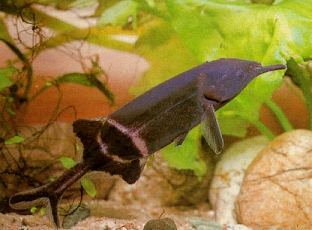|
|
|
 |
| Scientific name | Gnathonemus petersii |
| Common name | Elephant Nose, Peter's Elephantnose, Elephant Fish, Long-nosed Elephant Fish |
| Natural Habitat | Africa: Cameroon, Nigeria, Congo (formerly Zaire) |
| Appearance | Ths appearance of this fish is unique and quite unmistakable : brownish black with two vertical cream stripes through the anal/dorsal fins and a distinclive elongated downturned snout, at the end of which is the mouth. |
| Maximum size | This species can grow to 10 or 12 inches if kept under ideal conditions in a large tank. |
| Aquarium Compatibility | Peaceful : even when fully grown it is no threat to even the smallest of your fish because of its small mouth |
| Diet | Omnivorous; they particularly enjoy live foods such as bloodworm but will also accept frozen foods. Supplement feed with small sinker pellets and flake food. |
| Notes |
The elephant nose is one of that unusual group of fishes which emits an electic discharge; fortunately this is extremely weak and of no danger to the other fishes in your tank, or to you if you put your hand in the water or touch the fish. Despite several websites I have visited telling you to keep elephantnoses singly, they are actually shoaling fish and should be kept in a shoal of not less than three, as single fishes will often fail to thrive and may even die. Elephantnoses use their electric discharge to signal to each other and locate each other in the murky water of the rivers in which they live; they should be fed last thing at night, just before the aquarium lights are switched off, so they can forage for food under cover of darkness, and should be provided with hiding places where they can retreat to for safety if they feel threatened. They must not be kept in small aquaria - I would recommend a minimum size of 50 gallons. CAUTION : this is a scaleless fish and standard fish treatments for illness may not work and may even cause the death of the Elephant fish. Read all instructions on all packages carefully. |
Home Page ~ Index of Fishes ~ Aquarium set-up ~ Maintenance ~ Links